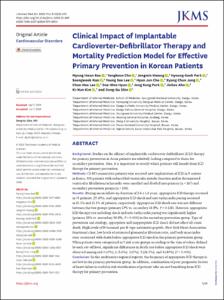KUMEL Repository
1. Journal Papers (연구논문)
1. School of Medicine (의과대학)
Dept. of Internal Medicine (내과학)
Clinical Impact of Implantable Cardioverter-Defibrillator Therapy and Mortality Prediction Model for Effective Primary Prevention in Korean Patients
- Keimyung Author(s)
- Hwang, Jong Min; Park, Hyoung Seob; Han, Seong Wook
- Department
- Dept. of Internal Medicine (내과학)
- Journal Title
- Journal of Korean Medical Science
- Issued Date
- 2020
- Volume
- 35
- Issue
- 9
- Abstract
- Background:
Studies on the efficacy of implantable cardioverter-defibrillator (ICD) therapy for primary prevention in Asian patients are relatively lacking compared to those for secondary prevention. Also, it is important to stratify which patients will benefit from ICD therapy for primary prevention.
Methods:
Of 483 consecutive patients who received new implantation of ICD in 9 centers in Korea, 305 patients with reduced left ventricular systolic function and/or documented ventricular fibrillation/tachycardia were enrolled and divided into primary (n = 167) and secondary prevention groups (n = 138).
Results:
During mean follow-up duration of 2.6 ± 1.6 years, appropriate ICD therapy occurred in 78 patients (25.6%), and appropriate ICD shock and anti-tachycardia pacing occurred in 15.1% and 15.1% of patients, respectively. Appropriate ICD shock rate was not different between the two groups (primary 12% vs. secondary 18.8%, P = 0.118). However, appropriate ICD therapy rate including shock and anti-tachycardia pacing was significantly higher (primary 18% vs. secondary 34.8%, P = 0.001) in the secondary prevention group. Type of prevention and etiology, appropriate and inappropriate ICD shock did not affect all-cause death. High levels of N-terminal pro-B-type natriuretic peptide, New York Heart Association functional class, low levels of estimated glomerular filtration ratio, and body mass index were associated with death before appropriate ICD shock in the primary prevention group. When patients were categorized in 5 risk score groups according to the sum of values defined by each cut-off level, significant differences in death rate before appropriate ICD shock were observed among risk 0 (0%), 1 (3.6%), 2 (3%), 3 (26.5%), and 4 (40%) (P < 0.001).
Conclusion:
In this multicenter regional registry, the frequency of appropriate ICD therapy is not low in the primary prevention group. In addition, combination of poor prognostic factors of heart failure is useful in risk stratification of patients who are not benefiting from ICD therapy for primary prevention.
- Alternative Title
- Clinical Impact of Implantable Cardioverter-Defibrillator Therapy and Mortality Prediction Model for Effective Primary Prevention in Korean Patients
- Publisher
- School of Medicine (의과대학)
- Citation
- Myung Hwan Bae et al. (2020). Clinical Impact of Implantable Cardioverter-Defibrillator Therapy and Mortality Prediction Model for Effective Primary Prevention in Korean Patients. Journal of Korean Medical Science, 35(9), 1–10. doi: 10.3346/jkms.2020.35.e49
- Type
- Article
- ISSN
- 1598-6357
- Source
- https://www.jkms.org/search.php?where=aview&id=10.3346/jkms.2020.35.e49&code=0063JKMS&vmode=FULL
- Appears in Collections:
- 1. School of Medicine (의과대학) > Dept. of Internal Medicine (내과학)
- 파일 목록
-
-
Download
 oak-2020-0043.pdf
기타 데이터 / 1.27 MB / Adobe PDF
oak-2020-0043.pdf
기타 데이터 / 1.27 MB / Adobe PDF
-
Items in Repository are protected by copyright, with all rights reserved, unless otherwise indicated.